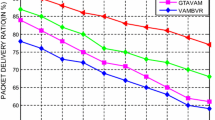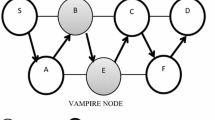Abstract
Vampire attacks on mobile nodes are considered as the potential threat since they influence the extent of connectivity maintained between them and they induce higher energy drain in the network. Vampire attack is also identified as the significant misbehaviour of mobile nodes as they are extensively exploiting the features of the incorporated routing protocol. The Fuzzy Rough Set (FRS) is the best option for quantifying uncertain behaviour of mobile nodes and thus this FRS based probabilistic variable precision is used in detecting vampire attacks. Fuzzy Rough Set Derived Probabilistic Variable Precision-based Mitigation Technique (FRS-PV-MT) is contributed in this paper for resolving the issues that could arise due to the stretch attack which is a noteworthy kind of vampire attack that needs to be addressed for reducing the latency of packet delivery due to the unnecessary elongation of the path in the network. FRS-PV-MT is better in detecting vampire attacks as they formulate greater and lower bounds of probabilistic decision variable based on the estimation of crisp factor determined using fuzzy membership grades. Simulation studies of FRS-PV-MT confirm its efficacy by exceptionally improving the throughput percentage rate by 12% and remarkably reducing the total overhead by 10% under varying data rate. The results also prove that FRS-PV-MT is remarkable over the compared baseline attack detection schemes by sustaining its performance by enhancing PDR by 12% and minimizing average end-to-end delay by 17%.












Similar content being viewed by others
References
Stojmenovic, I., & Lin, X. (2001). Power-aware localized routing in wireless networks. IEEE Transactions on Parallel and Distributed Systems, 12(11), 1122–1133.
Raikwar, M., & Mishra, P. (2017). A Mitigation Approach To Protect Wireless Sensor Networks Over Vampire Attack. International Journal of Computer Applications, 159(7), 25–28.
Vasserman, E. Y., & Hopper, N. (2013). Vampire attacks: draining life from wireless ad hoc sensor networks. IEEE Transactions on Mobile Computing, 12(2), 318–332.
Ye, J., & Dang, Y. (2017). A novel grey fixed weight cluster model based on interval grey numbers. Grey Systems: Theory and Application, 2(2), 12–22.
Zhong, S., & Wu, F. (2007). On designing collusion-resistant routing schemes for non-cooperative wireless ad hoc networks. In Proceedings of the 13th annual ACM international conference on mobile computing and networking—MobiCom '07 (Vol. 1, No. 2, pp. 33–42).
Altman, E., Avrachenkov, K., & Garnaev, A. (2009). Jamming in wireless networks under uncertainty. In 2009 7th International symposium on modeling and optimization in mobile, ad hoc, and wireless networks (Vol. 1, No. 2, pp. 23–35).
Jaramillo, J. J., &Srikant, R. (2007). DARWIN. In Proceedings of the 13th annual ACM international conference on mobile computing and networking—MobiCom '07 (Vol. 1, No. 1, pp. 11–22).
Li, F., & Wu, J. (2008). Hit and run: A Bayesian game between malicious and regular nodes in MANETs. In 2008 5th annual IEEE communications society conference on sensor, mesh and ad hoc communications and networks (Vol. 2, No. 1, pp. 23–34).
Li, X., Wu, Y., Xu, P., Chen, G., & Li, M. (2008). Hidden information and actions in multi-hop wireless ad hoc networks. In Proceedings of the 9th ACM international symposium on Mobile ad hoc networking and computing and advancement—MobiHoc '08 (Vol. 2, No. 1, pp. 12–24).
Cardenas, A. A., Radosavac, S., &Baras, J. S. (2007). Performance comparison of detection schemes for MAC layer misbehavior. In IEEE INFOCOM 2007—26th IEEE international conference on computer communications (Vol. 1, No. 2, pp. 43–52).
Joo, C., &Shroff, N. B. (2007). Performance of random access scheduling schemes in multi-hop wireless networks. In IEEE INFOCOM 2007—26th IEEE international conference on computer communications (Vol. 3, No. 1, pp. 24–31)
Bhatia, R., Kashyap, A., & Li, L. (2007). The power balancing problem in energy constrained multi-hop wireless networks. In IEEE INFOCOM 2007—26th IEEE international conference on computer communications (Vol. 1, No. 1, pp. 67–78).
Deng, J., Han, R., & Mishra, S. (2005). Defending against path-based DoS attacks in wireless networks. In Proceedings of the 3rd ACM workshop on security of ad hoc and sensor networks—SASN '05 (Vol. 2, No. 1, pp. 23–34).
Aad, I., Hubaux, J., & Knightly, E. W. (2004). Denial of service resilience in ad hoc networks. In Proceedings of the 10th annual international conference on mobile computing and networking–MobiCom '04 (Vol. 1, No. 1, pp. 45–56).
Doshi, S., Bhandare, S., & Brown, T. X. (2002). An on-demand minimum energy routing protocol for a wireless ad hoc network. ACM SIGMOBILE Mobile Computing and Communications Review, 6(3), 50.
Fotino, M., & De, F. (2011). Energy issues and energy aware routing in wireless ad hoc networks. Mobile Ad-Hoc Networks: Protocol Design, 2(2), 45–61.
Funding
This research work has not received any funding from any organization.
Author information
Authors and Affiliations
Corresponding author
Ethics declarations
Conflict of interest
The authors declare that there is no conflict of interest.
Additional information
Publisher's Note
Springer Nature remains neutral with regard to jurisdictional claims in published maps and institutional affiliations.
Rights and permissions
About this article
Cite this article
Srikaanth, P.B., Nagarajan, V. Fuzzy Rough Set Derived Probabilistic Variable Precision-Based Mitigation Technique for Vampire Attack in MANETs. Wireless Pers Commun 121, 1085–1101 (2021). https://doi.org/10.1007/s11277-021-08673-z
Accepted:
Published:
Issue Date:
DOI: https://doi.org/10.1007/s11277-021-08673-z




